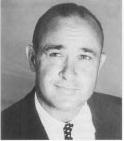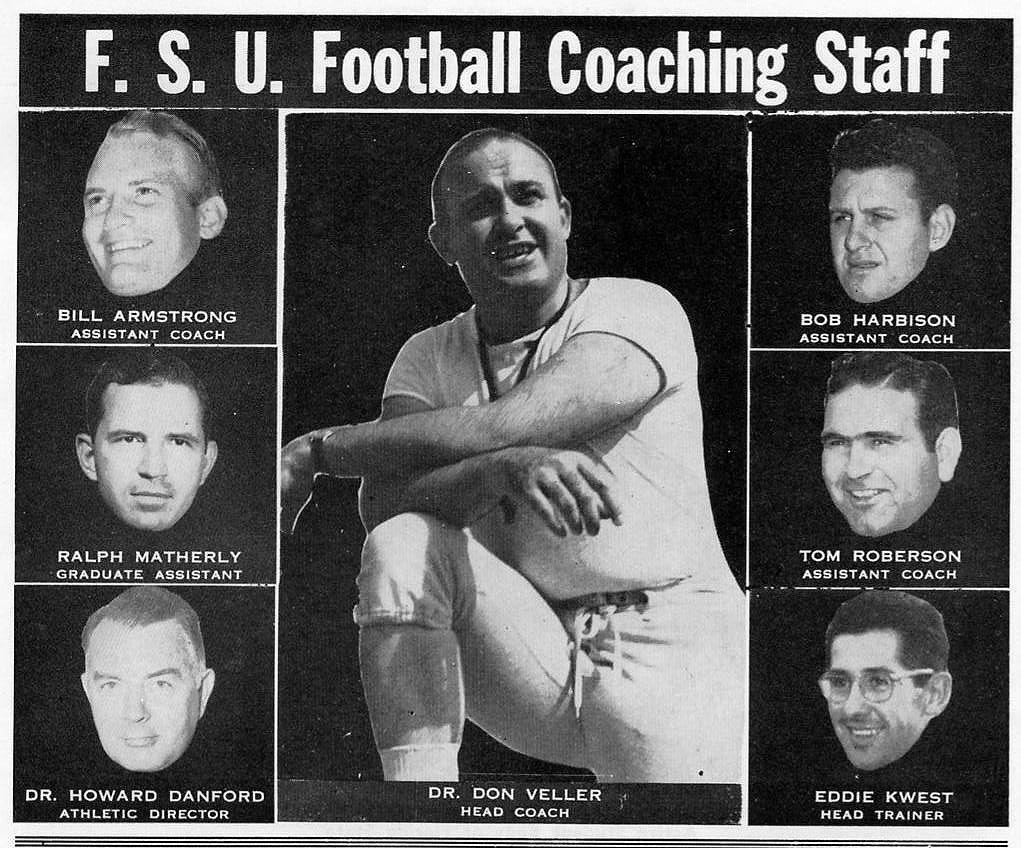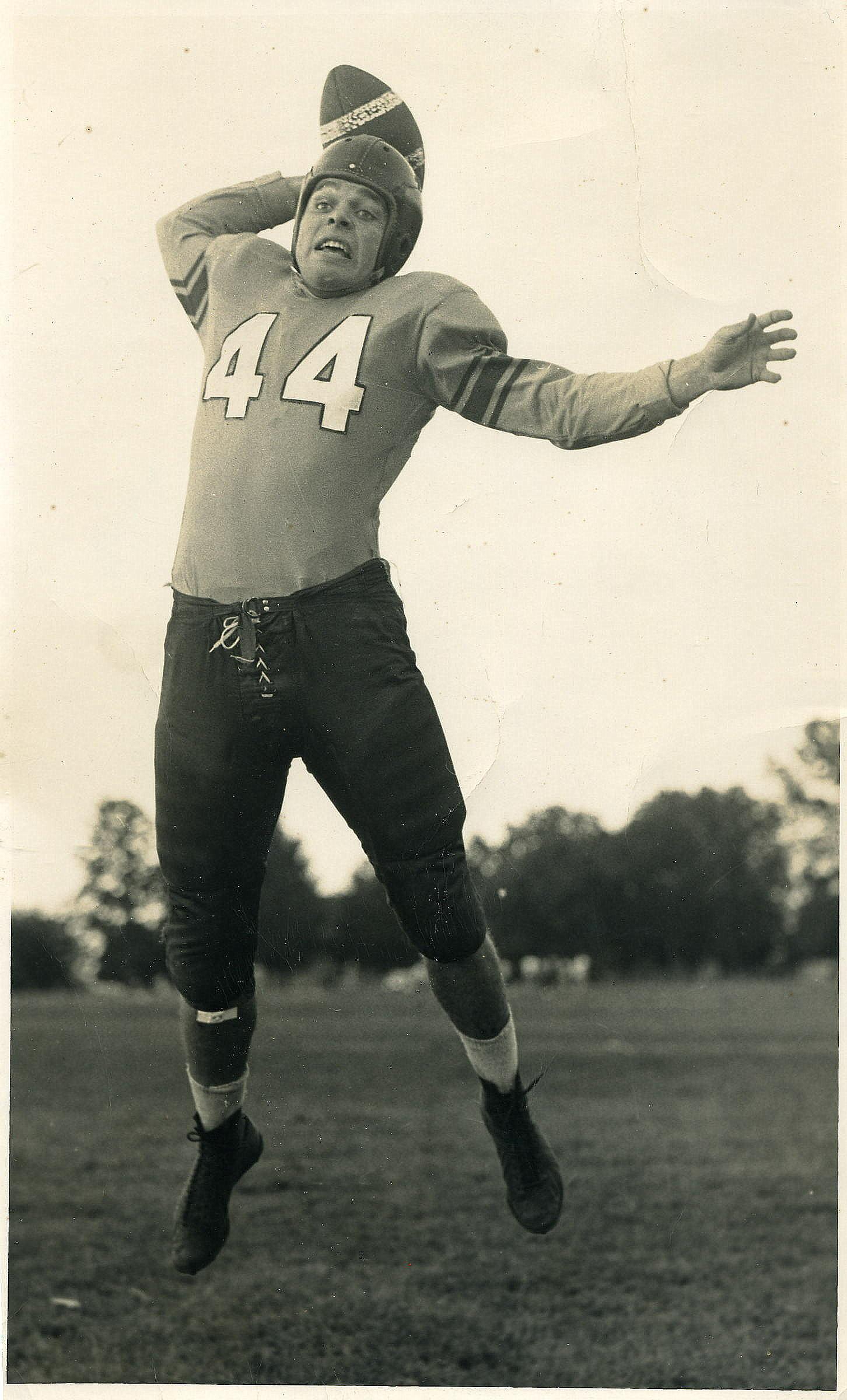
Don Veller
The Don Veller Football Years
By Jim Joanos
Don Veller touched a lot of lives. When he died in November at 94 years of age, he left a trail of great service to Florida State University. He also left memories of a very classy person. He should be remembered as one of the all time greats of FSU athletics.
Veller's death rekindled thoughts of some very interesting and fun years in FSU's football history. From 1948 through 1952, Veller was the head football coach. In that capacity, he led FSU to its first football victories in the modern era, its first conference championships, its first undefeated season, and its first bowl appearance and victory. Those five years were packed with accomplishments during a time when FSU football was new and fresh, exciting and fun. They were years in which FSU's football team dominated in southeastern small college football and took its first steps toward big time college football. They were the foundation years of FSU football.
Veller was born in Linton, Indiana, into a coal mining family. A leader from childhood, Veller was president of his sophomore, junior and senior classes in high school and graduated as the class's salutatorian. At Indiana University, he was a star halfback and in his senior year was the team's most valuable player. In 1934, in the last game of his college career, he had an 82-yard touchdown run against Indiana's most hated rival, Purdue, to insure victory. Following college, he was very successful as a high school coach for seven years in Elkhart, Indiana. When World War II broke out, like so many men of his generation, he spent the early nineteen-forties serving Uncle Sam. His military assignments included being chief of the Information and Education Division of the Third Air Force with the rank of major.
When the war ended, Veller went back to coaching, this time at the college level. He spent one year as athletic director, head football and track coach at Hanover College (Indiana). Then, Bo McMillin, invited him to come back to Indiana as an assistant football coach. His main responsibility was to coach the ends. He also coached the tennis team that year. He was there for only one year.
 |
Don Veller |
FSU came calling in early 1948 and asked Veller to become its head football coach. Veller's academic background was very important in FSU's decision, for Veller's job at FSU also required him to teach in the physical education department as an associate professor. As a college student, Veller had been outstanding in the classroom and had won the Big Ten Conference's medal for scholarship and athletics. Before FSU hired him, he had already obtained a Master's Degree and was finishing up in the Doctor of Philosophy program at Indiana.
When Veller was hired, FSU had just completed its first football season since 1904. In an abbreviated schedule, the Seminoles had gone zero and five. The first year had been totally makeshift.
At the time, the FSU's men's athletics program was located out at "West Campus". West Campus was a conglomerate of temporary wooden buildings and a couple of runways out at the end of Jackson Bluff Road which had served as Dale Mabry Air Base during World War II. Following the war, the premises were shared by FSU and the Tallahassee Airport. The football team practiced on what had been the military drill field. Some of the players dressed for practice in an old building that had accompanied the outdoor movie theatre. Others, perhaps, most of them, dressed in the nearby barracks where they lived. For home games, the players as well as large numbers of the other students were bussed to downtown Centennial Field for the Saturday night games. Veller could only get to Tallahassee for very short periods of time in the spring of 1948 because of his continuing responsibilities at Indiana. Consequently, he had to rely on his two recently acquired assistant coaches, brothers Charley and Bill Armstrong to conduct most of spring practice. The Armstrongs had been football players at Indiana.
One of the new candidates for the team that showed up for practice that spring was Ernie Reddick from nearby Chipley. Reddick had spent his freshman year and a quarter of his sophomore year attending Emory Junior College, in Valdosta, Georgia. He was attracted to FSU by the thought of going to school with "all of my friends from home." He also admits that the thought of "those pretty girls there" did cross his mind. In any event, he transferred to FSU in January of 1948. He does not remember much about his first days in Tallahassee but does remember being in the Sweet Shop on Jefferson Street and meeting "a pretty girl named, Joan." They would later be married and have been together ever since. They now spend the summers in Balsam, North Carolina, and the rest of the time in Cullman, Alabama.
Reddick also remembers spring practice in 1948. He became a wingback in Veller's Cockeyed-T formation which was an adaptation of the Tennessee Single Wing formation. Reddick describes the spring practice as a procedure through which they "sought to find out who was willing to make a tackle and who was willing to make a block." Many of the players that he met then became lifetime friends.
 |
Sometime after spring practice, Veller hired a third assistant, Bob Harbison. Harbison had also played football at Indiana. Harbison would be an FSU assistant football coach for many years thereafter. He also hired Eddie Kwest, who had been an assistant at Indiana as FSU's head football trainer. Reddick remembers that Kwest "had some sort of liniment that was used for muscle strain." It was effective for "when he put it on you, it burned the stew out of you so bad that you could not feel the muscle strain after that."
By summer, with Veller as the new coach, the view toward Florida State's football team took on an increased air of enthusiasm. Florida State continued to be a very attractive place to go to college for the former military personnel who were returning to civilian life. The former military men were joined by high school graduates from north Florida, south Georgia and Alabama. There were no athletic scholarships.
About eighty candidates for the team, including twenty-two lettermen from the year before, showed up for the two-a-day practices that began at 9 a.m. on Monday, September 13, 1948. Charlie Armstrong and Bob Harbison worked with the linemen while Veller and Bill Armstrong coached the backs. The workouts must have been pretty tough for in less than a week nearly thirty of the potential players had eliminated themselves from further competition. The sessions went on for nearly a month.
Veller's first season
On Saturday night, October 9, 1948, Florida State won its first football game since 1904 by beating Cumberland University 30 to 0 before 6,500 fans at Tallahassee's Centennial Field. The FSU team lost its next game at Erskine College 6 to 14. Reddick remembers that as his first road football game at FSU. The team traveled in an "old second-hand bus that had been painted up." Erskine is located in Due West, South Carolina. The team members slept "in a gymnasium on portable bunks." For meals, Reddick says they "had to cross a highway and eat in some kind of girls' cafeteria."
After Erskine, FSU went on to win its last six games. One unidentified writer described what Veller had done: "Veller took a group of boys that didn't win a game in 1947 and vaulted them to the Dixie Conference championship. His team didn't lose a conference game while winning four. His overall record for the year was seven wins and a lone loss to Erskine College by the slim score of 14-6." The conference championship was the first in FSU's football history.
It was during Veller's first season at FSU that I took my first out of town trip to see the Seminoles play. It was to see the Seminoles play Troy State in Dothan, Alabama. I was fourteen years old at the time. My older brother invited me to go with him and a friend up to Dothan, ninety miles away, for the game. We drove up in the afternoon and came back that night after the game. FSU won the game, 20-13, but what I remember most was something that happened before the game. It had been raining most of the day so the field was flooded with water. Shortly before kickoff, some people went out on the field and poured some kerosene or something flammable onto portions of the field and set fires to the puddles. It was neat watching them burn areas of the field. Reddick says that the burning apparently "did not do too much good for the field was still a mess to play on."
The second year under Veller was even more successful than the first. In FSU's first game of the 1949 season, the Seminoles administered the worst beating in the school's history upon an opponent, both before and since, when the team defeated a military team, Whiting Field, 74-0, at Centennial Field in Tallahassee. Following that beginning, the team went 8-1 during the regular season. The only loss was by a 12-6 score at Livingston State College to a team coached by another person who would later play a big role at FSU, Vaughn Mancha. The start of the game against Livingston State had to be delayed because there were no referees. Someone had forgotten to make the necessary arrangements. Consequently, referees had to be recruited from the fans who had come to see the game. Reports differ on who was selected. In any event, an unexpected officiating crew called the game. Although others did, Veller never criticized the circumstances under which FSU lost the game.
The Cigar Bowl
At the end of the 1949 regular season, FSU received its first ever invitation to play in a post season bowl game...the Cigar Bowl in Tampa. Before the 14,000 fans in attendance, FSU pummeled its opponent, small college powerhouse Wofford College of Spartanburg, South Carolina, 19 to 6. It was a huge upset victory for FSU. Wofford had entered the game sporting a 1949 season record of 11 and 0, and not having lost a game in over two years.
 |
Buddy Strauss |
Reddick did not play in the Cigar Bowl because of a dislocated shoulder but the names of some that did should be familiar to some of you as they occupy some very significant spots in the lineup of FSU all-time football heroes. Wyatt "Red" Parrish scored two of the Florida State touchdowns. Other offensive stars included end Norman Eubanks, backs Whitey Unquhart and Ken MacLean, and linemen Captain Hugh Adams, Jerry Morrical, Ted Hewitt and Dub Kendrick. On defense, Guard Bill Dawkins and Tackle Loren "Duke" Maltby, both had great games. The FSU most outstanding player of the game was Fullback-Defensive End Buddy Strauss who starred on both sides of the ball. He led all ball carriers in rushing. On defense, he made numerous tackles behind the line of scrimmage.
In Veller's third year, FSU had its first undefeated football season in the university's history when it went 8-0. The team also won the Dixie Conference for the third year in a row. There were three other events that school year worth noting. It was then that a young Army veteran attending FSU known as "Rube" Askew served as the student body president (technically, the position was then known as the "President of the University Government Association." It was that season that FSU opened its new football facility, now known as Doak S. Campbell Stadium. It was also the year in which Veller became Dr. Don Veller, as he received his PhD from Indiana University and became a full professor at FSU.
The last game of that 1950 season was especially memorable. It was sixteen degrees and the wind was blowing. There were long icicles hanging from the water tower in view from Campbell Stadium. I was shivering and kept moving about trying to find someplace where the wind was not blowing. Players on the field wore gloves. At halftime, Veller took the team into the team bus which was parked at the stadium and turned on the bus's heater. The rooms in the new stadium were not warm enough. In any event, FSU beat Tampa on a frigid day, 35-19 to complete a perfect season. Another special thing happened during that game. FSU's Tommy Brown had an 84 yard punt. That is still the record. I doubt that it will ever be broken. The ball went over the defensive back's head and just kept bouncing and rolling, rolling on the cold ground.
The 1950 team turned down an invitation to play again in the Cigar Bowl. The year before, the team had expected to receive commemorative watches for playing in the bowl. Instead, they got miniature rubber toy footballs. It had left a bad taste in their mouths. In addition, since they had no scholarships to play football, many of the players had Christmas jobs that allowed them to make some much needed money for school. They voted against the return trip to Tampa.
In 1951, Veller had another good season, going 6-2. The only losses were at the University of Miami, and to the University of Tampa in Tallahassee.
Thus, in Veller's first four years as head coach, FSU had gone 30-4 and established a winning tradition. But time had run out. The mature military veterans that FSU had depended upon so much had graduated. FSU had moved to a major college schedule. Scheduling Miami in 1951 had been the start of moving to a big time college schedule. The 1952 season included Louisville, VMI, North Carolina State, Mississippi Southern, and Georgia Tech. The step was too high, too soon. FSU had only since 1951 begun to offer football scholarships. The result was a disastrous 1952 season with FSU going 1-8-1.
The Later Years
The 1952 football season was the last that Don Veller would serve as head football coach. In January of 1953, he voluntarily stepped aside. After that, Veller went on to serve FSU in numerous ways. He continued his teaching and taught hundreds, maybe thousands, of students. He served as Associate Athletic Director for a period of time. He wrote extensively. For many years, he served as FSU's golf coach. His more famous golfers have included PGA golfers Paul Azinger, Hubert Green, Kenny Knox, Jeff Sluman, and Brian Kamm. He was honored by inclusion in a number of sports hall of fames including in 1980, the National Golf Coaches Hall of Fame. In addition, Veller, and his wife of seventy years, Frances, who preceded him in death by just ten days, made several generous financial contributions to FSU's sports programs.
At Don Veller's memorial service, the minister in charge, Wayne Cook, referred to Veller as being "incredibly humble" and spoke of the coach's "many accomplishments" and of "lots of love" that he had bestowed upon those who were fortunate to know him. It was most fitting. Veller's positive effect upon so many during his lifetime was borne out by those in attendance. Two of his first assistant coaches at FSU, Charlie Armstrong and Bob Harbison, were there. As was Vaughn Mancha, the coach at Livingston State who handed Veller his only loss in the 1949 season and who later became an assistant to Veller. Charlie Durbin, who drove the bus "Old Ironsides" which carried Veller's teams thoursands of miles to destinations throughout the southeast was there. So was Rueben Askew, the young FSU student leader when Veller first came to FSU who became governor of Florida and even a candidate for the presidency of the United States. Several former university presidents were there as well as numerous past and present team coaches and other entities from the FSU Athletics department. A large number of prominent bankers and community leaders also paid homage to the man that had meant so much to a growing Tallahassee. Even the music reflected upon the character and quality as well as the interests of the man when the pianist played Amazing Grace, the Old Rugged Cross as well as the FSU Alma Mater. Don Veller brought a lot of class to the FSU football program.